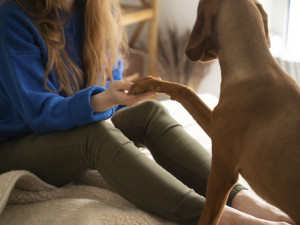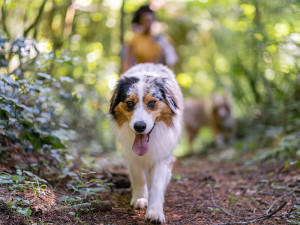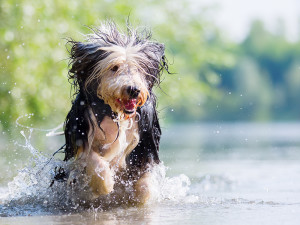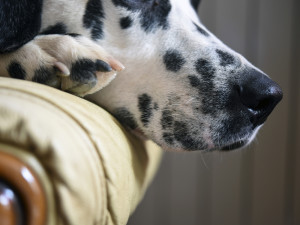It’s Hot Out There—Here’s How You Can Protect Your Pup’s Paws
Those perfect little toe beans need all the help they can get.

share article
While making sure your pup’s paws stay safe and healthy is always a top priority, this summer, pet parents, look out. It’s going to be a hot one! To play meteorologist for a moment: High pressure in the upper atmosphere causes the air beneath it to sink and compress, forming an extra-long, extra-hot “heat dome.” The entrée underneath that dome? Us. The National Weather Service saysopens in a new tab “the longevity of dangerous heat forecasted ... has not been experienced in decades.”
Clearly, life under the dome means making some necessary adjustments for you, your dog, and their paws. Rescue vet Dr. Rachel Warnes of the Oregon Humane Society told us that it’s “important to avoid things that will cause damage to the pads, like extreme heat, cold, and rough terrain.”
More water? Check. More shadeopens in a new tab? All you can find. But to get some paw-specific ways to protect your pup in Heat Dome ’24, we spoke to Dr. Bartley Harrison, a small animal veterinarian based in North Carolina and Dr. Jennifer Sperry, a veterinary advisor at Pets Plus Us based in Canada.
What are the common risks associated with hot pavement and surfaces for dogs’ paws during the summer?
Dr. Harrison: Dog pads are generally pretty tough, but it’s still possible for dogs to get blisters or burns on their pads from standing on hot pavement or rocks. This is especially true for dogs that haven’t had time to acclimate to the heat and activity after lazing around in the winter.
Dr. Sperry: Even relatively brief contact with hot pavement can result in pain and thermal injury (burns) to a dog’s paw pads. This can be recognized as lameness/limping, licking/chewing at the feet, redness, blisters, and peeling. Time spent on hot pavement can also contribute to an overall increase in a dog’s body temperature and increase their risk of heat stroke.
What are some misconceptions about summer heat and pups?
Dr. Sperry: Some people believe that domestic dogs are naturally equipped to withstand a variety of outdoor weather and temperature conditions, because of their wild ancestry. However, most of our pet dogs are very different from wild canids in terms of their anatomy, physiology, lifestyle, and behavior. As a result, planning and precautions are required to keep our canine companions safe during warm or hot weather.
How can dog parents recognize signs of paw pad burns or injuries caused by hot surfaces?
Dr. Sperry: When on the go, it’s critical to understand that not all dogs will display obvious signs of discomfort when walking on hot pavement. However, if your dog is limping, reluctant to walk, crying, or not behaving as usual on the leash, they could be experiencing pain or burning.
After a burn has occurred, a dog may be limping or lame, lethargic, reluctant to stand or walk, or licking/chewing at the feet. You may see visible redness, blistering, or peeling of the paw pads, revealing a raw and red surface.
What are the best preventive measures dog parents can take to protect their pets’ paws from hot surfaces?
Dr. Harrison: The best thing to do is to avoid walking outside during the hottest part of the day. If you can’t hold the back of your hand on the surface for five seconds without any discomfort, it's too hot for your dog. The other big thing is to avoid playing fetch or roughhousing on hot sidewalks, streets, patios, or pool decks. Stopping and starting on these hot surfaces is especially tough on paw pads.
Are there particular surfaces that are best to avoid?
Dr. Jennifer Sperry: Avoid cement, pavement, or tile surfaces, especially darker-colored surfaces, on hot and/or sunny days. Be aware that beach sand is just as hot for your pet as it is for your bare feet. Choose to walk in the morning or evening, when temperatures are lower and the sun is closer to the horizon. Exercise in shady, grass-covered areas.
When urban walking is unavoidable, consider using properly fitted booties. Keep in mind, your dog’s feet are one of their cooling mechanisms, so prolonged coverage during warm temperatures impairs their ability to regulate their body temperature. Take breaks and provide water frequentlyopens in a new tab.
Are there certain times of day when it’s safer to walk dogs during the summer?
Dr. Harrison: Early morning tends to be the safest time to walk dogs during the summer. Surfaces have had some time to cool off overnight and the temperature hasn’t started to rise yet. Evenings or nighttime are also good for walks. It’s best to avoid outdoor activities during the hottest part of the day. Maybe a quick trip to pee is OK, but save the long walks for the cooler hours.
Are there any surfaces or terrain that are safer for dogs to walk on during hot weather?
Dr. Sperry: Shaded dirt paths, wet sand, or grass are ideal surfaces for warm-weather walks.
How often should a dog’s paws be checked for signs of damage or irritation during the hot months?
Dr. Harrison: Be sure to check your dog’s paws for any problems after a long walk outside, especially if you know they were walking on hot surfaces. It never hurts to take a quick look at your dog’s paws while they’re getting belly rubs. Getting them used to having their feet handled reduces stress for nail trims and vet visits. You should definitely take a look at your dog's paws if they're ever showing signs of lameness or discomfort.
Dr. Sperry: Paws should be checked during regular bathing or grooming activities, or any time you notice your dog limping, protesting exercise, licking, or chewing at their feet.
What role does regular grooming play in keeping their feet healthy?
Dr. Sperry: Regular grooming helps to keep nails short and reduce debris accumulation in the hair between toes. This can reduce the risk of injury during walks, play, and navigating uneven terrain.
What should you look for if you think your dog has burned their paws from the heat of the ground?
Dr. Harrison: Check their paw pads for any signs of tenderness when pressed on. For larger dogs, you may need to press on each toe pad separately. Also look for visual signs of burns or blistering like thin areas of skin, redness around the edges of the pads, abrasions, or oozing wounds.
Dr. Sperry: Secure booties opens in a new tabin the proper size, with good ventilation and a thicker bottom are best for hot weather. Balloon-type rubber booties are best avoided, due to their thin sole and poor ventilation. Firm boots that don’t come in a variety of sizes run the risk of offering a poor fit, which can damage nails, and lead to blisters and chafing.
What are some at-home care tips for keeping a dog’s paws healthy and moisturized during the summer?
Dr. Sperry: Regular exercise on grass or dirt during moderate temperatures helps to maintain the naturally thick layer of protective tissue on the paw pads. Feet should be dried thoroughly after swimming or bathing, and before/after using any footwear.
Time spent wearing booties should be minimized. A natural beeswax or coconut oil moisturizer can be used on dry paw pads, especially for seniors, but is not usually necessary for healthy adult dogs.
What immediate steps should a dog parent take if they suspect their dog has burned their paws?
Dr. Sperry: Discontinue any outdoor activities or exercise. Get to a cool place where your pet can rest. Use a cone collar to prevent licking/chewing at the feet. Contact your veterinarian for advice on how to relieve pain and manage wounds.
When should a pet parent seek veterinary care for a dog’s paw injury due to heat?
Dr. Sperry: If you see visible signs of thermal injury, such as redness, raw pads, blistering or peeling; if your pet exhibits signs of pain such as crying or licking/chewing at the feet; or if you notice any lameness or lethargy lasting longer than a dayopens in a new tab, you should seek veterinary care.
Is paw balm a good way to protect their paw pads in the summer?
Dr. Sperry: Geriatric or ill pets may be more prone to dry or cracking pads. For these pets, it is best to apply moisturizers or balmsopens in a new tab in the evening, when your pet is able to rest in a temperature-controlled environment.
What ingredients should dog parents look for (or avoid) in paw-care products?
Dr. Sperry: Products containing dyes, scents, or alcohols can be irritating to your pet’s skin. Because dogs often lick their feet, paw care products should only contain ingredients that can safely be ingested in small amounts, such as beeswax or food-grade oils.
How do humidity and different climates affect the risk of paw pad injuries in dogs?
Dr. Sperry: Humidity reduces a dog’s ability to naturally cool off during the heat, just like it does for people. Timing exercise carefully opens in a new tabis especially important during humid weather. In low-humidity environments, it is important to remember that bright sun can heat up ground temperatures, even on relatively cool days.
Do certain breeds or sizes of dogs have higher susceptibility to paw injuries from heat?
Dr. Sperry: Smaller dogs, and those with a low percentage of body fat (like sighthounds), have less fat cushioning in their paw pads. These dogs may be more vulnerable to thermal injuries to their feet.
References:
Maps Show opens in a new tab “ Hot, Hot Heatopens in a new tab ” Headed to the Northeast U.S. That Could Break Dozens of Records, Put Millions at Riskopens in a new tab

T. Kent Jones
T. Kent Jones is a writer and broadcaster whose work has been featured on The Daily Show on Comedy Central, The Rachel Maddow Show on MSNBC, Morning Sedition with Marc Maron on Air America Radio and in many publications and comedy websites. He lives in New York City with his wife, Kelly, and their rescue Schnoodle, Pops, who suffers much foolishness with stoic forebearance.
Related articles
![Australian shepherd panting with tongue out, walking ahead of owners.]() opens in a new tab
opens in a new tabHow to Keep Your Pets Safe During Extreme Heat Waves
As scorching summer temperatures become the new normal, here’s how to help keep your pets cool and healthy.
![Woman holding a beagle in warm dappled summer light]() opens in a new tab
opens in a new tabYou’ve Got a Summer-Lovin’ Pup. Here’s How to Keep Them Safe
Some like it hot (but not most dogs). Here are the season’s health hazards, from fleas to foxtails.
![Shepherd dog playing with yellow ball at the beach]() opens in a new tab
opens in a new tabHow to Keep Your Dog Safe at the Beach This Summer
5 tips to help your pup have fun in the sun — safely.
![Bearded Collie running in a lake]() opens in a new tab
opens in a new tabWhen Drinking Too Much Water Is Deadly
How to keep your swim fan safe.
![Black lab swimming in pool]() opens in a new tab
opens in a new tabWater Hazard Tips to Keep Your Swimming Dog Safe
Keep your pup safe in the pool, a pond, or the ocean.
![Spotted dog with a close up of his nose]() opens in a new tab
opens in a new tabWhat to Do If Your Dog Has a Cracked, Broken, or Torn Nail
A vet explains when you can treat the injury at home — and when it’s best to seek professional help.









